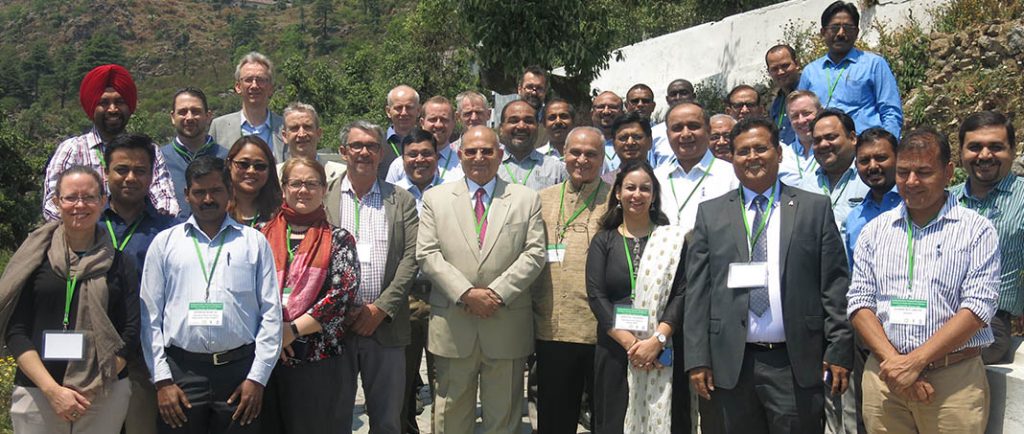Scaling Nutrient Management in South Asian Cereal Systems

Degradation in soil organic carbon is not a new occurrence but the accelerated intensity of decline in recent decades is cause for concern. However, considerable efforts are being made in the field of precision nutrient management (PNM) in South Asia to ensure that the right type and amount of nutrients are used based on site-specific soil conditions. Despite many scientific advances achieved in PNM, imbalanced application of fertilizers is still common in India, as evidenced by a recent CSISA study. Lack of awareness and understanding among farmers about the benefits of optimized fertilizer use could be a factor, according to Sheetal Sharma, IRRI Soil Scientist and Nutrient Management Specialist – South Asia. “Various strategies of PNM are being developed but the science is not being channeled to the end users. However, we now have a variety of new tools that can be leveraged for PNM leading to improved management of natural capital, optimization of resource usage and maximization of crop yields,” she added.
In collaboration with the Bill & Melinda Gates Foundation, Indian Council of Agricultural Research and Trust for Advancement of Agricultural Sciences, CSISA organized a convening on Scaling PNM in South Asian Cereal Systems from 27-29 April in Mussoorie, India. Participants included representatives from the government and fertilizer industry, as well as agronomists, soil scientists and remote sensing specialists from various CGIAR institutions. The goal of the convening was to identify pragmatic strategies for increasing the agronomic efficiency and profitability of soil fertility management at scale. It follows last year’s National Dialogue on Efficient Nutrient Management for Improving Soil Health, the recommendations of which have been adopted as the New Delhi Soil Health Declaration – 2015.
During the discussions at the convening, it emerged that current innovations in institutional data science and spatial data availability represented a remarkable opportunity to map physical and biological characteristics of crops and their environment rapidly and cost-effectively and with greater precision at scale. Such tools are being used for precision nutrient management as well as in-season adaptive management and can be done at the national level at an affordable scale. The Indian Government, for example, will require testing of 40 million soil samples per year as part of its new Soil Health Card Scheme – an ambitious program launched in 2015 at the cost of Rs. 5.7 billion. Its objective is to, among other things, help urea consumption come down 20-25 percent. Under the scheme, the government plans to issue individual soil cards to farmers that will carry crop-wise recommendations for nutrients and fertilizers to improve productivity through judicious use of inputs.
However, the various soil testing labs across the country currently have a capacity to test only 17.8 million samples per year. Additionally, conventional soil tests remain cumbersome with huge problems related to accuracy and reproducibility. Neither do they characterize the nutrient pools nor do they produce any absolute measure of nutrient availability. On the other hand, new methods, such as spectroscopy-based soil assessments, are highly reproducible and cheap. “Spectral analysis means that the majority of your lab work, you’re doing at the cost of electricity,” said Markus Walsh, Science Coordinator, Africa Soil Information Service (AfSIS).
Kaushik Majumder, Vice President, Asia and Africa, International Plant Nutrition Institute (IPNI), also reiterated the importance of partnerships for scaling PNM practices and tools. “The most important learning from our experience is that partnerships are essential for the successful out scaling of any new tool and ownership of the tool by these partners even more so,” he stated. Based on these discussions, specific potential partnerships were prioritized to ensure CSISA’s role in scaling precision nutrient management remains complementary to the national system.
Policy Reforms
A roundtable discussion was also organized by IFPRI on 2 May in New Delhi on Policy Reform Options to Improve Soil Nutrient Management in India. The meeting focused on public expenditure priorities, current subsidy schemes and the Government of India’s Soil Health Card Scheme.
The figure for average fertilizer usage in India stands at 100 kilograms per hectare compared to 300 kilograms per hectare in China. At the same time, fertilizers here, especially for nitrogen, are not even 30 percent efficient – making the financial expenditures even more staggering.
According to Pramod K. Joshi, IFPRI South Asia Director, “Fertilizers have contributed significantly to increasing productivity but more recently have created numerous problems for the government, especially financially. With a bill of more than US$ 11 billion, the first major problem at the macro level is subsidies. The second is leakages with 24 percent going to inefficient production units and 41 percent diverted through urea; only 35 percent of the subsidy amount actually makes it to the farm sector. It is also important to note that we are trying to reduce subsidies while at the same time increasing consumption.” Participants in the discussion largely agreed that the fertilizer subsidy policy needs to be reviewed thoroughly, with a focus on incentivizing rather than penalizing.
This article is authored by Ashwamegh Banerjee, Assistant Communications Specialist, CSISA.
